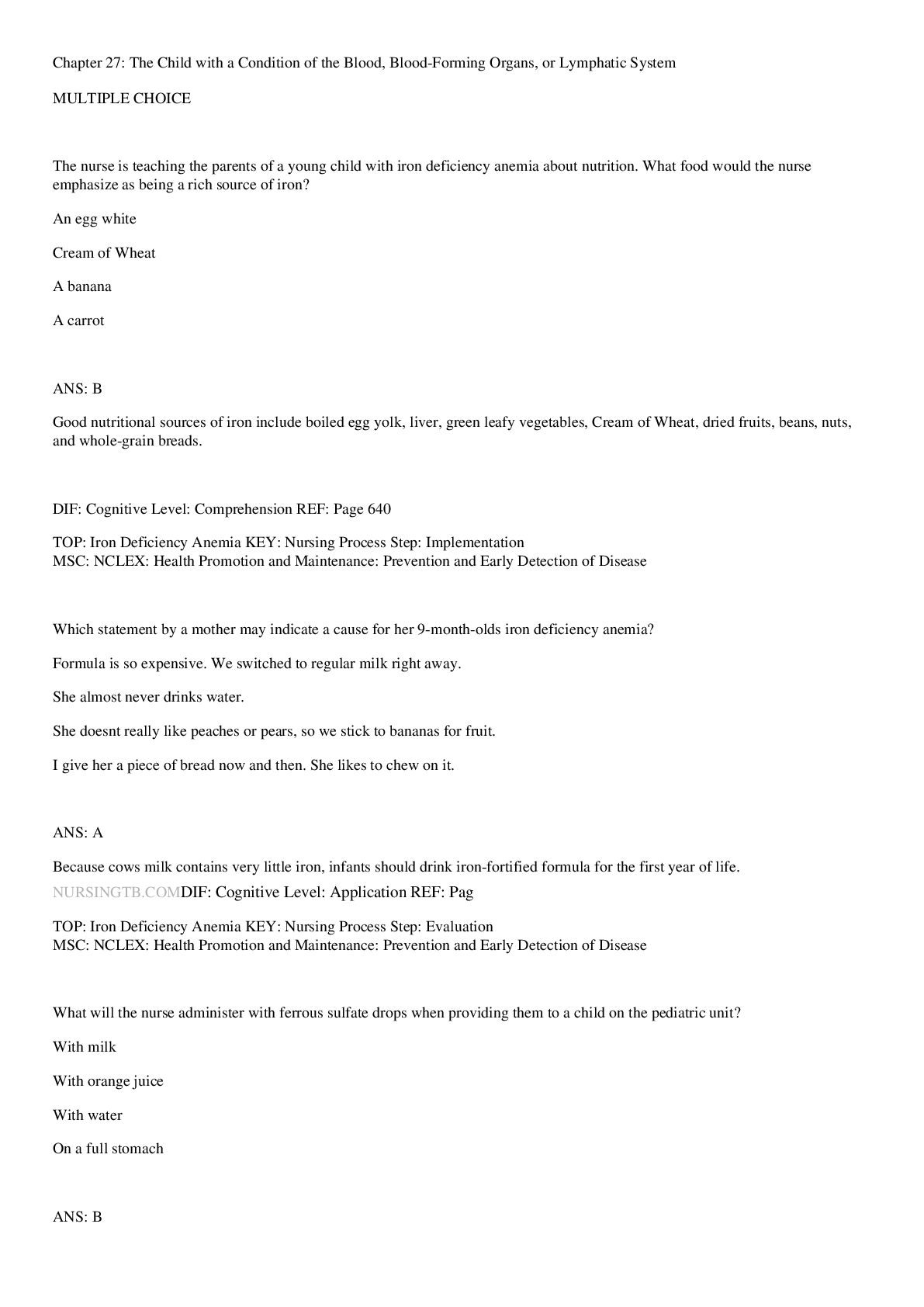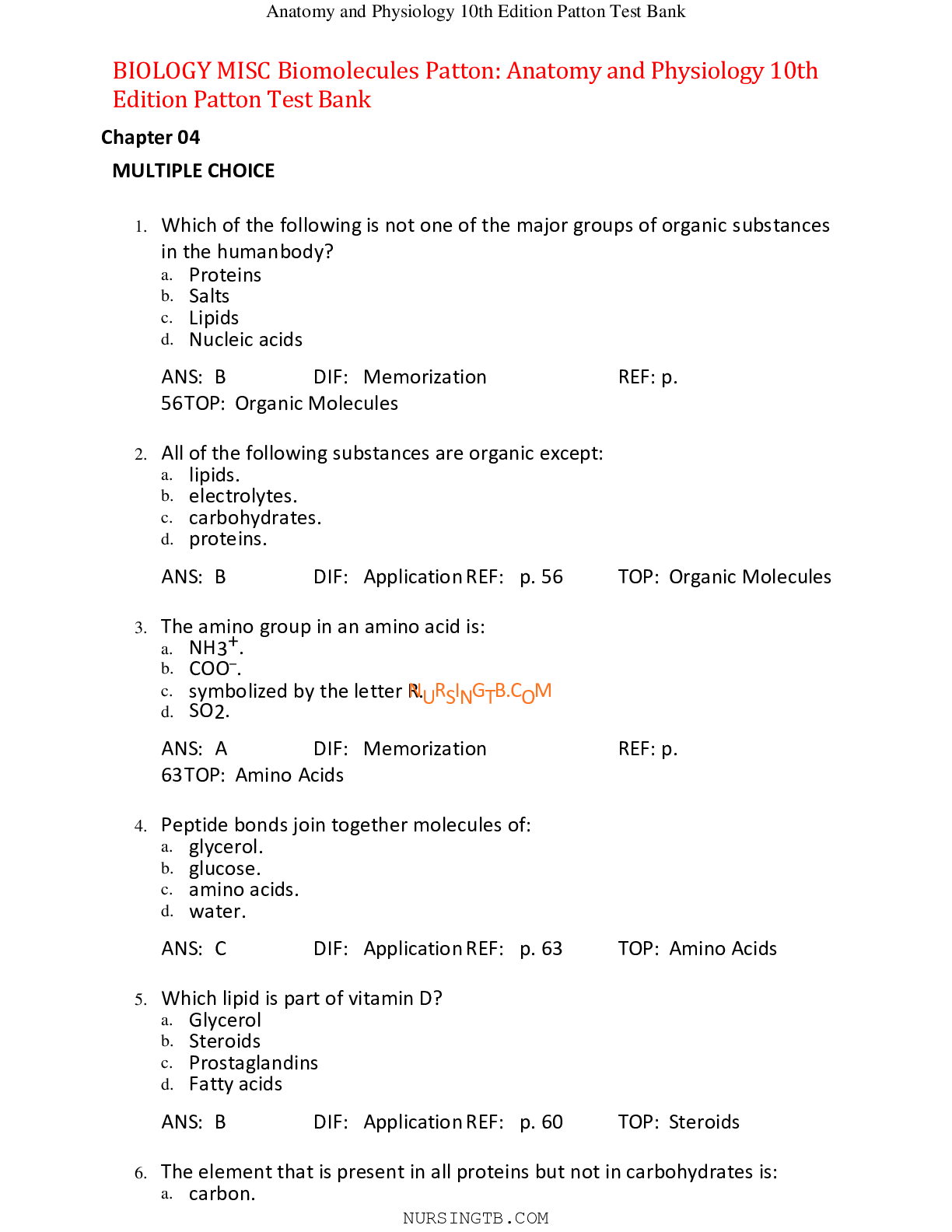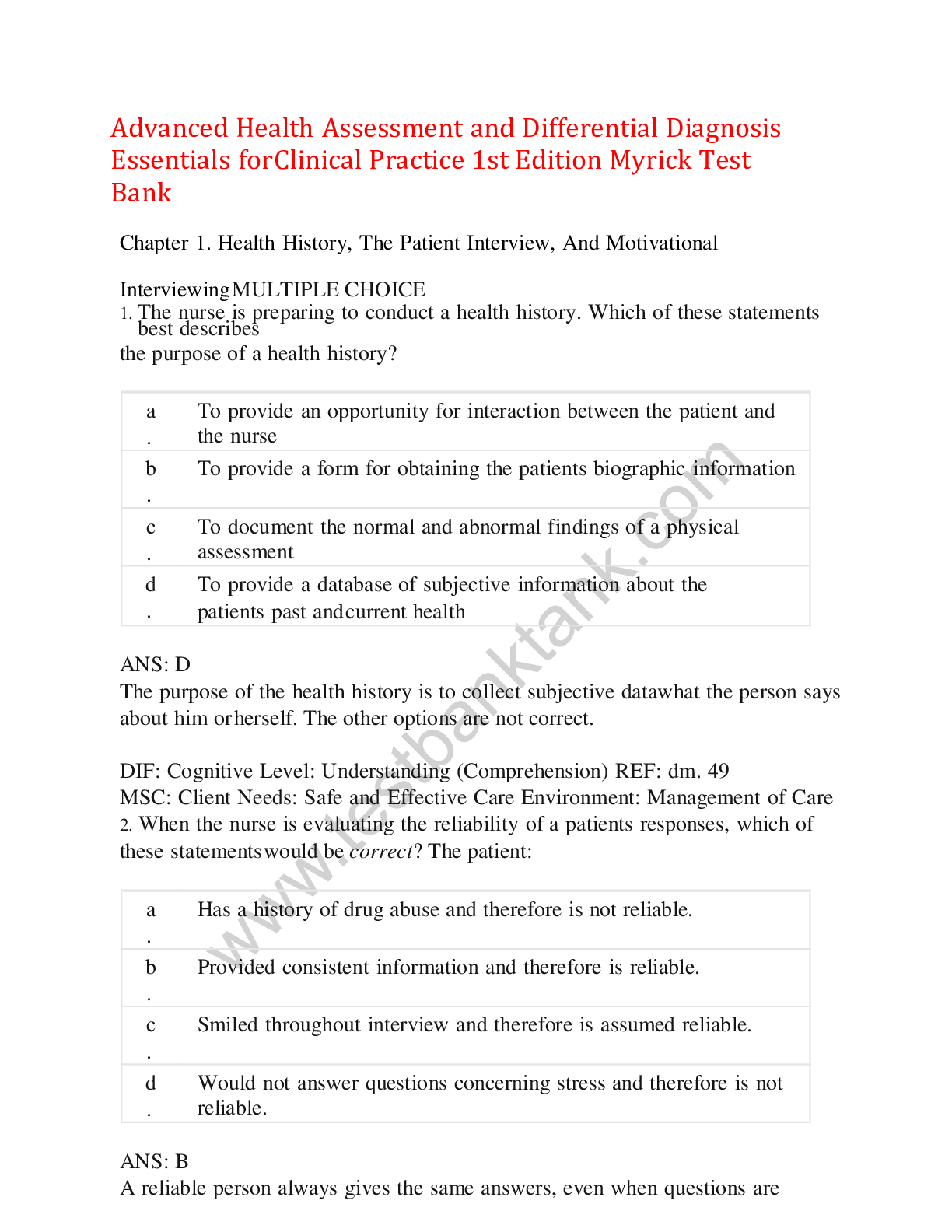*NURSING > TEST BANK > Test Bank: Antianxiety Drugs Keltner : Psychiatric Nursing, 8th Edition,100% CORRECT (All)
Test Bank: Antianxiety Drugs Keltner : Psychiatric Nursing, 8th Edition,100% CORRECT
Document Content and Description Below
Test Bank: Antianxiety Drugs Keltner : Psychiatric Nursing, 8th Edition MULTIPLE CHOICE 1. By what mechanism does lorazepam reduce anxiety? a. Increasing serotonin levels b. Blocking dopamin... e receptors c. Depressing norepinephrine levels d. Potentiating gamma-aminobutyric acid (GABA) ANS: D Benzodiazepines enhance the effects of the inhibitory neurotransmitter GABA, slowing neuronal firing. They do not affect dopamine, serotonin, or norepinephrine. DIF: Cognitive level: Understanding TOP: Nursing process: Planning MSC: Client Needs: Psychosocial Integrity 2. A patient started diazepam 5 mg twice daily 6 months ago. Now, the patient requires 10 mg to achieve the same effect. What phenomenon is responsible for this situation? a. Addiction b. Tolerance c. Dependence d. Disinhibition ANS: B Tolerance is the need for incrNeasRing IamoGuntBs o.fCa suMbstance to achieve the same effects. The other terms, defined in the text, do not account for this phenomenon. DIF: Cognitive level: Understanding TOP: Nursing process: Evaluation MSC: Client Needs: Physiologic Integrity 3. A patient diagnosed with agoraphobia took alprazolam 0.5 mg three times daily for 3 months and then discontinued it. The next day the patient called the nurse reporting insomnia, shakiness, and sweating. What should be the focus of the nurse’s assessment questions? a. Whether the patient may have also been drinking alcohol or taking antihistamines. b. The possibility that the patient has built up tolerance to alprazolam and needs an increased dose. c. The likelihood that the patient is having withdrawal symptoms from abrupt discontinuation of the drug. d. Whether the patient has progressed to panic attacks and needs a nonbenzodiazepine medication. ANS: C The patient’s symptoms suggest benzodiazepine withdrawal. The nurse knows that patients often attempt to manage their own care by discontinuing medication when they begin to feel better. Benzodiazepines should be slowly withdrawn if withdrawal symptoms are to be avoided. Drinking alcohol would result in different symptoms. Development of tolerance and panic attack symptoms would be different from those mentioned. DIF: Cognitive level: Analyzing TOP: Nursing process: Implementation MSC: Client Needs: Physiologic Integrity 4. An emergency room patient was very anxious after a serious car accident. Lorazepam 2 mg intramuscularly was administered. One hour later, which finding indicates to the nurse that the medication was effective? a. Improved problem-solving skills b. Increased alertness c. Increased verbalization d. Reduced environmental scanning ANS: D Benzodiazepines mute incoming stimuli and evoke less reaction. The hyperalertness and environmental scanning that accompany high anxiety are notably decreased when the drug is effective. Impaired problem-solving is a negative outcome. Because of its sedating properties, the individual might not be more alert, talkative, or active. DIF: Cognitive level: Applying TOP: Nursing process: Evaluation MSC: Client Needs: Physiologic Integrity 5. A patient has taken diazepam for 1 week for back spasms. The patient reports “feeling sleepy all the time.” Which response will best address the patient’s concern? a. “The dosage probably needs to be decreased.” b. “Drowsiness indicates a paradoxical reaction to the drug.” c. “Tolerance to the sedative effect of the drug will develop quickly.” d. “Sleepiness is an unavoidable side effect of nonbenzodiazepine drugs.” ANS: C NURSINGTB.COM Tolerance to most side effects of benzodiazepines, including drowsiness, develops quickly. There is no need to decrease the dosage. Drowsiness is an expected reaction, not a paradoxical one. Valium is a benzodiazepine. DIF: Cognitive level: Applying TOP: Nursing process: Implementation MSC: Client Needs: Psychosocial Integrity 6. A patient has taken clonazepam for years to manage panic attacks but impulsively stopped the drug. Thirty hours later, the patient comes to the emergency room in distress. What is the nurse’s priority action? a. Begin seizure precautions. b. Refer the patient for addiction counseling. c. Institute a behavior modification program. d. Prepare to administer flumazenil. ANS: A There is evidence to suggest that abrupt withdrawal of clonazepam might precipitate status epilepticus. With this in mind, withdrawal from long-term use warrants seizure precautions. The patient does not have an overdose, so flumazenil is not indicated. The other options are inappropriate. DIF: Cognitive level: Analyzing TOP: Nursing process: Implementation MSC: Client Needs: Physiologic Integrity 7. Which patient behavior should the nurse identify as the greatest risk for overdose with a benzodiazepine? a. Taking the drug with antacids b. Taking the drug before meals c. Combining the drug with alcohol d. Experiencing depression as well as anxiety ANS: C Benzodiazepines taken with alcohol produce marked central nervous system (CNS) depression, even death. Antacids prevent absorption. Larger doses of benzodiazepines by themselves are rarely lethal. Depression in and of itself is not an indicator of overdose risk. Suicidal ideation might be present, but benzodiazepines by themselves are rarely lethal. DIF: Cognitive level: Applying TOP: Nursing process: Evaluation MSC: Client Needs: Physiologic Integrity 8. The nurse would expect to administer flumazenil for a patient with which diagnosis? a. Acute alcohol withdrawal b. Benzodiazepine overdose c. Benzodiazepine-resistant anxiety d. Psychotic disorder ANS: B Flumazenil is a benzodiazepine receptor antagonist. Response occurs within 30 to 60 seconds; however, it might not reverse associated respiratory depression. Because it has a short duration of action and does not speed metabolism of benzodiazepines, administration of flumazenil might need to be repeated several times. Flumazenil is not indicated for treatment of any of the other conditionsN. URSINGTB.COM DIF: Cognitive level: Evaluating TOP: Nursing process: Planning MSC: Client Needs: Physiologic Integrity 9. A patient received one dose of flumazenil. What is the nurse’s next action? a. Carefully observe for benzodiazepine overdose symptoms. b. Teach the patient about dietary restrictions. c. Prevent injury during seizure activity. d. Force 500 mL oral fluids over 2 hours. ANS: A Flumazenil, which is given to patients who have overdosed with benzodiazepines and so the nurse must be vigilant for signs that the patient is reverting to the preflumazenil state. None of the other options are relevant to this medication. DIF: Cognitive level: Applying TOP: Nursing process: Implementation MSC: Client Needs: Physiologic Integrity 10. The nurse would expect a patient with which comorbid diagnosis to have a magnified response to the usual dose of a benzodiazepine drug? a. Rheumatoid arthritis b. Migraine headache c. Hepatic cirrhosis d. Osteoporosis ANS: C Benzodiazepines are metabolized in the liver. The cirrhotic liver will slow the metabolism rate of the drugs, leading to an exaggerated response. The distracters are not associated with decreased hepatic function. DIF: Cognitive level: Understanding TOP: Nursing process: Evaluation MSC: Client Needs: Physiologic Integrity 11. A patient in the emergency room has status epilepticus. The nurse should anticipate administration of what medication? a. Diazepam (Valium) b. Buspirone (BuSpar) c. Clorazepate (Tranxene) d. Chlordiazepoxide (Librium) ANS: A Valium is the drug of choice in status epilepticus because of its rapid action. Each of the other benzodiazepines has a slower onset of action. Buspirone is not indicated to treat seizures. DIF: Cognitive level: Applying TOP: Nursing process: Implementation MSC: Client Needs: Physiologic Integrity 12. The teaching plan for a patient beginning buspirone should include information identifying this drug as having what property? a. Norepinephrine inhibitor b. Serotonergic antagonist c. Serotonin agonist d. GABA inhibitor ANS: C NURSINGTB.COM It is believed that buspirone is a serotonin agonist. Because buspirone is not a benzodiazepine, it does not bind to benzodiazepine receptor sites, affect GABA, or affect norepinephrine. This accounts for its different effects and lack of CNS depression as side effects. DIF: Cognitive level: Understanding TOP: Nursing process: Assessment MSC: Client Needs: Physiologic Integrity 13. A patient seeking treatment for anxiety says, “I can’t think. My job depends on my ability to think. I need medicine, but the drugs I took a few years ago made me too sleepy. I could lose my job.” What information is most important for the nurse to consider when formulating a response? a. All antianxiety medication has sedating properties. b. Buspirone alleviates anxiety without sedation or cognitive clouding. c. The patient’s description of anxiety does not warrant treatment with medication. d. The patient may be trying to manipulate the nurse to assist with getting the desired prescription. ANS: B Buspirone’s action is entirely different from that of the benzodiazepines. It reduces anxiety, with its accompanying concentration and cognitive problems, but without CNS depression. The patient’s description of anxiety indicates that it is interfering with daily life, so medication may be helpful. There is no evidence that the patient is trying to manipulate the nurse. DIF: Cognitive level: Applying TOP: Nursing process: Implementation MSC: Client Needs: Physiologic Integrity 14. A patient diagnosed with social phobia begins propranolol. The nurse should teach the patient to expect what reaction to this therapy? a. Sympathetic nervous system symptoms of anxiety will be reduced. b. A sense of euphoria for 30 minutes after taking the drug. c. Experience amnesia for the social situations that are most intimidating. d. Feeling a little drowsy but having no orthostatic hypotension. ANS: A Propranolol is a beta blocker that interrupts the physiologic responses of anxiety associated with social phobias, such as sweaty palms. Bradycardia may be associated with lightheadedness. The other options are not likely. DIF: Cognitive level: Applying TOP: Nursing process: Implementation MSC: Client Needs: Physiologic Integrity 15. A patient states, “I have the same thoughts over and over. I feel compelled to count all my footsteps.” The nurse can expect the health care provider to prescribe what medication? a. Alprazolam b. Propranolol c. Clonazepam d. Clomipramine ANS: D NURSINGTB.COM Clomipramine is an antidepressant that has proven effective for obsessive-compulsive disorder (OCD). The other drugs have no proven effectiveness in treating OCD. DIF: Cognitive level: Applying TOP: Nursing process: Planning MSC: Client Needs: Physiologic Integrity 16. What medication information should the nurse provide the patient newly prescribed buspirone? a. Produces profound sedation. b. Will be effective in 7 to 10 days. c. Has a high risk for development of dependence. d. Is often associated with cross-tolerance with other CNS depressants. ANS: B Buspirone provides anxiety relief within 7 to 10 days from the time it is begun. For this reason, benzodiazepines are continued for their anxiolytic effect and gradually tapered as the buspirone becomes effective. The other options are incorrect. DIF: Cognitive level: Applying TOP: Nursing process: Implementation MSC: Client Needs: Physiologic Integrity 17. A patient had five emergency room visits in the past month and reports, “I feel so nervous. I think I’m having heart attacks.” The patient is diagnosed with panic attacks. Which comment by the nurse shows understanding of treatment for panic attacks? a. “Selective serotonin reuptake inhibitors (SSRIs) are often helpful for long-term treatment and prevention of panic attacks.” b. “Benzodiazepine tranquilizers are therapeutic for long-term treatment and prevention of panic attacks.” c. “No medications are particularly helpful for panic attacks. Let’s work on some strategies to help you manage your fears.” d. “Panic attacks result from an instability of the neurotransmitter acetylcholine. Meditation will be more helpful than drugs.” ANS: A Selective serotonin reuptake inhibitors (SSRIs) are approved for panic disorder and might be the most effective and safest agents for prophylaxis and long-term treatment. Benzodiazepines are effective during a panic attack but should not be used for long-term treatment because of the abuse and dependence potentials. It’s important that the nurse show compassion for the patient’s distress. Meditation may help overall, but not during panic attacks. DIF: Cognitive level: Applying TOP: Nursing process: Implementation MSC: Client Needs: Psychosocial Integrity 18. What is the half-life of diazepam for an older adult likely to be? a. 10 hours b. 30 hours c. 40 hours d. 80 hours ANS: D NURSINGTB.COM Because of decreased liver size and function in older adults, the half-life of benzodiazepines is markedly lengthened to 80 hours. Benzodiazepines with long half-lives are unsuitable for older adults. DIF: Cognitive level: Understanding TOP: Nursing process: Evaluation MSC: Client Needs: Physiologic Integrity 19. A health care provider prescribes lorazepam for an anxious older adult at a longer than usual dose. To assure patient safety, what is the nurse’s best action? a. Assess for a history of drug abuse. b. Administer the drug as prescribed. c. Confer with the health care provider. d. Assess the patient’s pupillary reaction to light. ANS: B Lorazepam is a benzodiazepine that has a short half-life. It might be administered safely to older adult patients, although the dose should often be modified downward. It is inadvisable to give benzodiazepines with longer half-lives to older adult patients. None of the other options support safe lorazepam therapy for this patient. DIF: Cognitive level: Applying TOP: Nursing process: Implementation MSC: Client Needs: Physiologic Integrity 20. A patient who has been taking a benzodiazepine for panic attacks is to be started on buspirone. Which instruction should the nurse provide? a. “Take decreasing doses of the benzodiazepine for several days until the buspirone becomes effective.” b. “Stop taking the benzodiazepines immediately. Wait 2 days, and then start the buspirone.” c. “You should take buspirone only once a day. More frequent dosing can cause dependency.” d. “Tolerance to buspirone may develop in about a month, requiring larger doses to be prescribed.” ANS: A Two factors suggest that the patient should take tapering doses of benzodiazepine while beginning buspirone therapy. Benzodiazepines should be tapered gradually for discontinuation to avoid withdrawal. Buspirone takes 7 to 10 days to begin to exert its therapeutic effect. The other statements about buspirone are incorrect. DIF: Cognitive level: Applying TOP: Nursing process: Implementation MSC: Client Needs: Physiologic Integrity 21. When a patient reports using both alprazolam and propofol, which inference applies? a. The combination of these medications will not result in a drug-drug interaction. b. Potentially lethal sedation and CNS depression would be expected with this drug combination. c. Tolerance to propofol probably developed very quickly in the presence of alprazolam. NURSINGTB.COM d. This drug combination was safe, but the patient needs close medical supervision. ANS: B Propofol, an anesthetic, would have a predictable additive effect with alprazolam in producing significant sedation and CNS depression. While the patient needs closer medical supervision, one cannot state that the combination of drugs was safe. Tolerance to alprazolam would occur regardless of use of propofol. DIF: Cognitive level: Analyzing TOP: Nursing process: Evaluation MSC: Client Needs: Physiologic Integrity 22. Which individual would be most likely to experience a paradoxical reaction to a benzodiazepine drug? a. A child with attention-deficit hyperactivity disorder (ADHD) b. An adult with obsessive-compulsive disorder c. A teenager with an eating disorder d. An adult with major depression ANS: A Paradoxical reactions to benzodiazepines are most likely in children, older adults, and persons with poor impulse control (such as ADHD) or organic brain syndromes. DIF: Cognitive level: Analyzing TOP: Nursing process: Assessment MSC: Client Needs: Physiologic Integrity MULTIPLE RESPONSE 1. The teaching plan for a patient beginning oxazepam should include what instructions? (Select all that apply.) a. Take the drug on an empty stomach. b. Avoid discontinuing the drug abruptly. c. Stop taking the drug if side effects occur. d. Drink only moderate amounts of alcohol. e. Avoid herbal preparations. ANS: B, E Patients must be informed that abrupt discontinuation of benzodiazepines produces withdrawal symptoms. Use of herbal preparations such as kava-kava and valerian can produce harmful additive effects. The other options contain information that is inappropriate to teach patients. DIF: Cognitive level: Applying TOP: Nursing process: Implementation MSC: Client Needs: Physiologic Integrity 2. A patient takes antacids, cimetidine, and phenytoin. The health care provider prescribes a benzodiazepine for anxiety. Which drug interactions is the patient at risk for experiencing? (Select all that apply.) a. Increased plasma level of benzodiazepine related to cimetidine therapy b. Increased absorption of the benzodiazepine if taken with the antacid c. Euphoria and disinhibition associated with phenytoin therapy d. Serotonin syndrome assoNciatRed wIithGcimBet.idCineMuse e. Potential phenytoin toxicity ANS: A, E Cimetidine increases the plasma level of benzodiazepines. The benzodiazepine interferes with phenytoin metabolism, thus increasing serum levels of the anticonvulsants. The distracters do not reflect actual interactions. DIF: Cognitive level: Applying TOP: Nursing process: Planning MSC: Client Needs: Physiologic Integrity 3. A patient in the emergency room is suspected to have an overdose of benzodiazepines. Which assessment findings validate this diagnosis? (Select all that apply.) a. Blood pressure 180/94 mm Hg b. Diminished reflexes c. Hypervigilance d. Somnolence e. Confusion ANS: A, D, E Benzodiazepine toxicity may result from an overdose. Assessment findings include hypotension, somnolence, confusion, and diminished reflexes. DIF: Cognitive level: Applying TOP: Nursing process: Assessment MSC: Client Needs: Physiologic Integrity [Show More]
Last updated: 10 months ago
Preview 1 out of 16 pages

Reviews( 0 )
Document information
Connected school, study & course
About the document
Uploaded On
Oct 18, 2021
Number of pages
16
Written in
Additional information
This document has been written for:
Uploaded
Oct 18, 2021
Downloads
0
Views
35





























